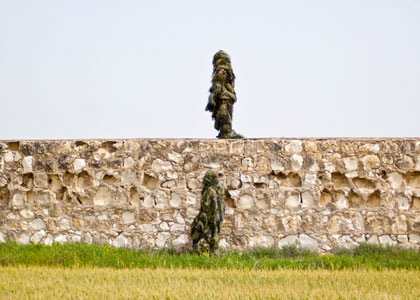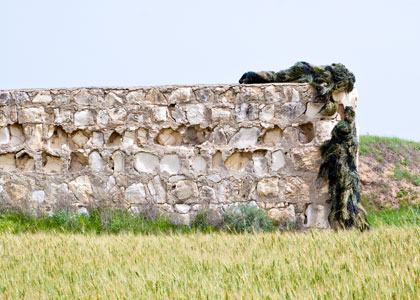Fearful Days: A Trilogy
Curator: Drorit Gur Arie
22/09/2011 -
08/11/2011

Dafna Shalom’s three video works, “Fearful Days: A Trilogy,” comprising the installation presented in the current exhibition, are associated with the time frame of the Jewish month of mercy, Elul. These works are tied with the series of video and sound works The Time Changer, which addresses short, mainly daily time spans—the transitions between day and night (Song of the Sea, 2004), between night and day (Arvit [Evening Prayer], 2008), and between one week and another (Hamavdil, 2008). Alluding to the opening and closing of the Jewish calendar, the trilogy offers a broader reading of the passing time, while exploring a politics of identity in a language which blends textual and visual.
Each of the three works is centered on a slightly different space of occurrence in terms of the geographical location, the story, and the depicted figures. In terms of their contents, however, the works are interconnected, each of them intertwining similar characteristics as a type of echo, alongside unique independent qualities. All of them explore a human-beastly struggle for basic existential survival. The underlying ideas are articulated via visual images—such as a repertoire of costumes, military camouflage colors, and a martial arts choreography, or metaphorically—via an “army of bees” and their relationship, as subjects, with the queen bee. The works’ militaristic facet attests to engagement with domination, conquest, and victory—in affinity with the local political, cultural, and national reality, as well as with gender and the battle between the sexes. All three works investigate the passage of time, endeavoring to mark a space of time for contemplation of the spectrum of feelings typified by tensions between traditionalism and modernity, bestiality and humanity, aggression and spirituality.
Man’s existence in wild nature, while attempting to domesticate it, is accompanied by an infinite cyclic motion linked with the world of Jewish ritual and the Jewish prayers incorporated in the soundtrack. Extracted by the artist from original tapes of cantorial music, the invocations are combined with contemporary interpretations, interweaving the voices of singers Dikla and Smadar Levy in chapters of prayer for the Day of Atonement. The dissonant traditional sound thus transforms into a unique hybrid melody with which contains sharp transitions between silence and singing, recitation and response, a male choir and the voice of a solo female cantor. Furthermore, the soundtrack surrenders a Mizrahi-Arab diction which challenges the unity of Jewish-Israeli identity.
The shooting angle oscillates between a broad panoramic view and close-up, between the whole and its parts. The cyclic movement, present in each of the works, beats with a gaze. The world of ritual and prayer is typified, as aforesaid, by repetitive movement as an iterative, meditative, physical act; it is also associated with the annual cycle of religious ceremonies and prayers. Accordingly, the chapters of the trilogy, in their affinity with the Days of Awe, are presented as a “time-specific installation,” corresponding with the modernist concept of a “site-specific installation.” Shalom’s interest in prayer may be ascribed to her father’s occupation as a teacher of Jewish prayers in Aden, Yemen.
The three works are typified by multi-medial wealth, spanning photography, fashion, dance, and sound. This totality makes for total, physical, and conceptual expression of diverse, at times antithetical, contents. Shalom, who hails from the “plastic” and photographic mediums, emphasizes the material characteristics of the landscape types, the fabrics, hair, masks, and costumes, as well as the way in which the film operates both as a whole and as an assembly of discrete frames.
Yamim Noraim (Fearful Days) #1, 2006, 2:55 min
The work was created in the aftermath of the controversial Second Lebanon War, close to the Days of Awe. The video portrays a ritual of smearing a face with camouflage paints before going into battle, transforming the body for the sake of self-defense as an animal instinct fighting for one’s survival. The artificial coloring or covering of the body enable assimilation in one’s surroundings to the point of disappearing. It conjures up the act of make-up—camouflage for the purpose of seduction or masquerade, and may also be associated with the application of paint onto the canvas in the practice of painting. The ritual act is supplemented with an element of gender discernible in the tension between the sexes following the emergence of a man and a woman. The notion of couplehood is harnessed for the act of going into battle in the socio-political as well as interpersonal sense. The coloring is accompanied by a performative act in which the male figure and the female figure unite into a single hybrid entity. It is a fusion of masculine and feminine in the mythological, Jewish-Kabalistic sense; a melting of paint and body, exterior and interior, as well as a blending of the identities of place, religion, and nationality in the local political context. Hiding under the guise of paint and mask, as an act with an archaic-primitive dimension concealing a violent sexual aspect, stands in contrast to the worshipper’s introversion under his prayer shawl in order to reach spiritual elation and break free from mundane, beastly existence.
Yamim Noraim (Fearful Days) #2, 2007, 5:42 min
The second video work in the trilogy is based on a close-up of a honeycomb in a beehive. The monochromatic shots and the continuous cyclic motion of the bees, generate the appearance of an infinite, golden surface where indecipherable occurrence takes place. The bustling poetic landscape ostensibly harbors a spatial and social regularity analogous to the hierarchical system of religion, which strives to introduce order into chaos and to distinguish between good and evil, finite and infinite. The interrelations created between the queen bee and her industrious workers organize the habitat of their short lives. It is precisely the close-up, however, that elicits the sense that the bees have lost their way, much like the viewer. The choreography of the bees’ cyclic motion and the camera work come together to form an ongoing dance on the verge of disintegration. A hymn is played against the beehive views, drawn from the Days of Awe prayers—performed by contemporary singer Dikla, interwoven with singing by a male chorus; a woman’s voice leads the singing, bringing together the bee kingdom and the Kingdom of Heaven.
Yamim Noraim (Fearful Days) #3, 2010, 14:57 min
A type of summation of the previous two videos, the occurrences in this work ranges between a practiced, stylized choreography of dance or martial arts to a violent duel. The bodily movements—between combat and dance—appear, at times, as a war which is meant to lead to slaughter and victory, at times as a manifestation of erotic closeness. The grappling of the two male figures takes place in a historical site near Kibbutz Be’eri intended for storage of ammunition during the British Mandate period, but was never used. It is a nonplace-place, a site on the verge of destruction. Its walls create a structural frame akin to an archaic décor for an obscure implied drama. The rhythm of the work, the geometrical format, and the visual cleanness are tantamount to minimalistic elements.
The two figures engage in a ritualistic type of activity. The scene invokes the sense of a raw, primordial occurrence involving contact with nature and the beastly dimension, as a pre-lingual ancient mythical space. The two figures, their heads covered with camouflage fibers, sustain sensory and sensual relationship like two animals which either play or wrestle in a sporting contest of sorts. Each sport ritual demands preparation for the “task” and special concentration so that the players may rise above their physical and mental capacities, in similar manner to the underlying principles of religious rite, where participants take part in a structured liturgical ritual for the purpose of ecstatic spiritual elation which transcends temporal physical existence. The occurrence involving the two dancers/rivals—the aforesaid struggle-battle-game-prayer—oscillates between poles: between animal and man, matter and spirit, sacred and profane; between God as a Jewish addressee and the Mizrahi-Arab prayer, as though Shalom endeavors to round the line and dissolve the distinctions in the name of the measure of Mercy.



